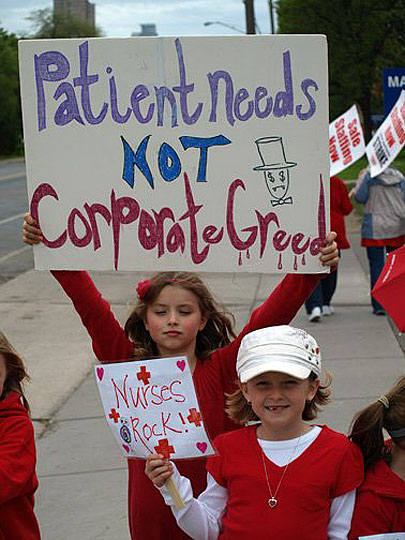Twin Cities Nurses Roll Back Hospitals’ Attacks

The day an open-ended strike by 12,000 Twin Cities nurses was set to begin, the nurses instead ratified a three-year contract by 90 percent. The July 6 deal fought off steep pension and health care concessions and included modest raises but failed to win the Minnesota Nurses Association’s chief goal: enforceable nurse-to-patients ratios. The nurses had pulled a one-day warning strike June 10 and followed up with an 84 percent vote to strike indefinitely. Union leaders credit the strike and strike vote, along with their concerted efforts to educate patients and the public, with moving the 14 Twin Cities Hospitals, which bargained together, off their demands to decimate pensions and increase health care premiums. Among other changes, the hospitals wanted to require nurses to work till age 65 in order to retire without penalty, as opposed to the “rule of 85” that lets them add their age plus years of service to determine eligibility. MNA President Linda Hamilton, a staff nurse at Children’s Hospital, said the strike had “99 percent compliance” and that more than 40 unions, as well as some legislators and faith groups, supported the months-long campaign that included vigils and a rally. They walked the picket line, gave money, and provided technology for voter turnout. Thousands of citizens pledged their support on an online sign-up form. Give $10 a month or more and get our "Fight the Boss, Build the Union" T-shirt. The union fought off an attempt to “float” RNs to any unit or to other hospitals with no notice or orientation, a practice nurses say would be unsafe for patients. “They also wanted to take away our language on unit closure,” said Hamilton. “If a nurse feels it isn’t safe to take another patient, she has the right to say, ‘I can’t and I won’t.’” The MNA plans to use the momentum from three months of internal mobilization and educating the public to launch a campaign around staffing. Hamilton said the campaign will include electing politicians who support a safe staffing bill; educating members on using the language they obviously have to say no; documenting unsafe situations for the media; and teaching patients to ask “how many other patients do you have tonight?” and to shop around for hospitals with better staffing levels. “We want the hospitals to be fighting each other, not us,” Hamilton said. The MNA website includes news footage of nurses criticizing the deal for not winning safe staffing as well as interviews with those voting yes.
SUPPORT LABOR NOTES
BECOME A MONTHLY DONOR
